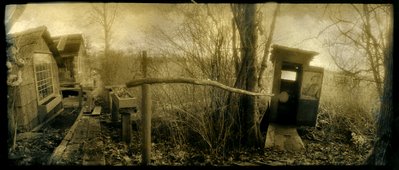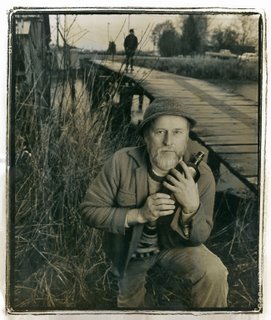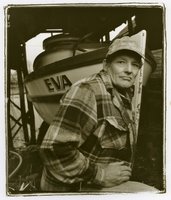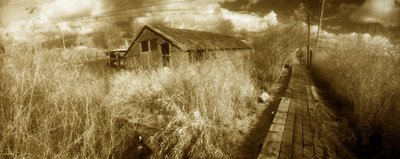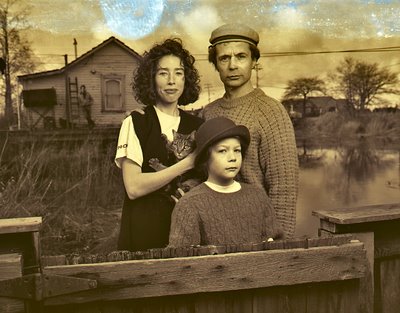Thursday, February 07, 2008
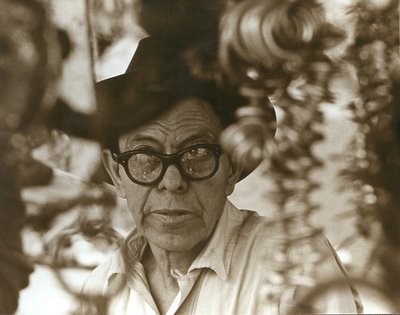
Today and yesterday I went to see a collection of photographs at the Vancouver Art Gallery that are from the George Eastman House in Rochester, New York. The photographs encompass the period called pictorialism which spanned the 19th and the beginning of the 20th century.
Every time I see a show like this I grieve that I rarely go out to take pictures for fun, outside of the ones I take of my granddaughters. The Spanish saying, the title of today's blog says, "Eyes that don't see, heart that doesn't feel." Is that what is happening to me? I am taking some pictures today of a model friend called Jo-Ann. I feel melancholy, perhaps the lingering cold, perhaps the bleak weather. I will try to keep my eyes open and I will hope to feel a bit more again.
The picture here I took half a century ago in the Lagunilla market in Mexico City. The camera was a Pentacon F with a Steinheil 135mm lens.
Sleeping Beauty & Rebecca Snubs Spirits
Tuesday, February 05, 2008
"On the count of 10 this man will die."
A man falls in the water, he struggles as Max Von Sydow calmy counts down, 10, 9, 8... Europa a 1991 film directed by Lars Von Tier.
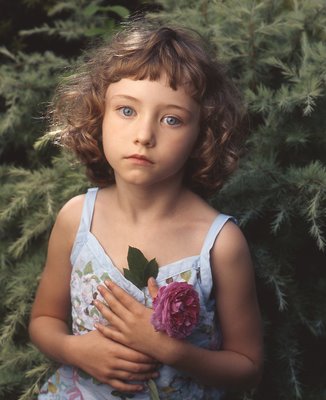
Last Saturday Rebecca asked me from the living room, "Papi, what's a posthumous portrait?"
It had all begun when she had told me that she really did not believe in my idea that if we returned to a place where one of our loved ones (or even unknowns) had walked by we would in some way walk through their presence in some form of ghostly spirit. I had told her about Homero Aridjis who wrote:
Invisible ancestors
walk with us
through the back streets
car-noises
the stares of children
young girls's bodies
cross through them
Weightless and vague
we travel through them
at doorways that no longer are
on bridges that are empty
with the sun on our faces
we too
move toward transparency. Homero Aridjis - Letter From Mexico
I have taken Rebecca to the old CP train station at the foot of Seymour Street. We sat down once, on one of the benches and I recounted how my grandmother had told me when I was 8 or 9 in Buenos Aires that she had left Manila in 1920, a penniless widow, with her three children, to live in the Bronx. She told me they had disembarked from a Japanese ship in a magical place that had enormous conifers and snow capped mountains, that was called Vancouver. She told me they had walked into a cavernous train station (the CP Station) to take a train to Montreal and from there to New York City. We looked up to the high celings and I explained that we did not need much of an imagination to see the four of them walking with their bags to the train platform. If we got up we could even, perhaps walk right through them as Aridjis wrote in his poem. If one could still hear the sound of the Big Bang, I explained it was no less likely that the presence of a human being would have been diluted to nothing.
Obviously Rebecca had been giving much thought to the idea of spirits. She thinks that one of her friends from school, who lives across the street from the cemetery on 41st and Fraser, is a tad too religious. She has told me this and I have recommended that she show tolerance.
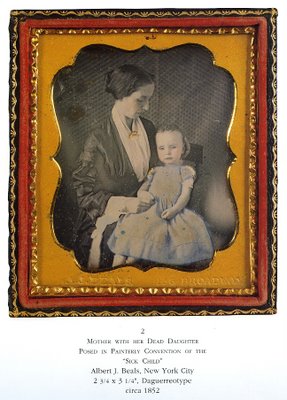
On Saturdays, Rebecca likes to go through my many photography and picture books. Her favourite is George Hurrell's very big book, Hollywood. But this time I placed on her lap Sleeping Beauty - Memorial Photography in America by Stanley B. Burns, M.D. (Twelvetrees Press, 1990). It didn't take long before she asked me about the pictures. "They are mostly portraits of dead children," I answered and then explained that because of a high mortality rate in children in the 19th century it was fashionable to have portraits taken of one's dead children. In some cases these portraits were the only tangible token or proof of their short existence. Rebecca looked at the book over and over. I mention that as soon as photography was invented and lenses and photographic emulsions became fast enough to record fleeting moments, photographers tried to capture the transition from life into death but that nobody had ever succeeded. Whatever it was that made eyes look alive, or dead in the portraits, had something to do with the existence of some invisible but somehow palpable spirit. She protested, "These pictures don't look real." "They were originally b+w photographs or silvery Daguerreotypes that were then coloured by hand," I explained, "That's why they look unreal. Colour photography had yet to be invented." This made Rebecca silent and when her mother Hilary arrived for supper in the evening she immediately sat down with her and showed her the book. I wonder which book will be on her lap next Saturday?
The colour photograph of Rebecca here I took in 2004. She is posing with the English Rose, R. 'William Shakespeare'. When I look at it I can see (in spite of the fact that it is in colour) something of the very much alive Alice Liddell that the Reverend Dogson captured in the 19th century. Is there something of that Rebecca of 2004 still in her now? Do spirits thin out?
Monday, February 04, 2008
Sunday night I watched the 1998 Mexican film La Otra Conquista by director/writer Salvador Carrasco. It was in Spanish, the flowery Spanish of the 16th century and in Náhuatl the language spoken by the Mexican peoples of the State of Mexico. Náhuatl would be almost the same as the language of the ancient Aztecs. 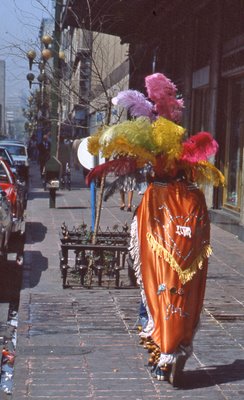 I was forced to see the film almost as if it were a silent film in that I had to guess such obvious lines like, "The gods have abandoned us!" and some that were more complex that somehow I had perhaps grasped because of my Catholic upbringing and my 15 year stay in several parts of Mexico before I moved to Vancouver. When it became quite violent Rosemary abandoned me and I felt a profound sense of loss in not being able to share the magnificence of this film with anyone that I might know. The film brought to mind two wonderful novels on the conquest of Mexico. The first by Spanish novelist and statesman Salvador de Madariaga, was published in 1942. In Spanish it is called El Corazón de Piedra Verde and in English it was published as The Heart of Jade. Unless you read (with a very Spanish point of view) Bernal Díaz del Castillo's (he was a soldier who fought with Hernán Cortés) Historia Verdadera de la Conquista de la Nueva España, your only readily available source of information on the conquest of Spain was Madariaga's Heart of Jade or the swashbuckling but extremely innacurate 1948 Hollywood film, Captains from Castile with Tyrone Power and Jean Peters. Cesar Romero played Cortés in an early prequel to his Joker. In 1991 the situation was brought to some balance by Mexican writer Homero Aridjis who published Memorias del Nuevo Mundo which reads sort of like a conquest of Mexico with large dabs of magic realism. This superb novel (one of my favourites ever) has only been translated into French. Few in North America will understand the difference between Columbus Day (even 50 years ago) with the Latin American Día de la Raza which translates to the Day of our Race, infering the mixing of the Spanish with Indian blood to form a new mestizo race. Few monuments to Christopher Columbus leave out the presence of the Indian. The one in Mexico City is extremely elaborate. And yet as my mother used to point out there was not one street or avenue in Mexico City named after the conquistador Hernán Cortés. It was in the early 1950s that Mexican Bantamweight champion, Raúl "Ratón (mouse)" Macias began to talk about the colour of his skin being bronze. He advertised a Mexican imitation of Coke called Mexicola. You could sense that there was a beginning source of pride about being of native origins. At the time many women refused to shave their legs since Mexican peoples had little body hair. Men of humble origins tried to grow moustaches. In the late 60s Mexico City passed an ordinance prohibiting its police officers from growing moustaches. The hair on their legs or those minute moustaches proved that, no matter how dark their skin was they had glorious Spanish blood! By eliminating the moustache the police department wanted to eliminate racism within its ranks. I often wonder if Frida Kahlo's moustache was less protofeminist protest and more an assertion of her European roots. In Argentina the racial barrier between the lighter skinned Argentines with the darker aboriginals can be clearly seen by the not endearing but deprecating term "cabecitas negras" or "little black haired heads" to denote those of local ethnic background. Argentine rugby and polo teams have always managed to keep the colour light skinned either through the money needed to participate or simply by first having to be members of exclusive sports clubs. One of the few avenues for economic advancement for those cabecitas negras are the football teams. Only when Maradona (an obvious cabecita) was famous all over the world did he become almost accepted in his country by the upper crusts. And when he went on his drug bust shenanigans the excuse that he was a common cabecita was raised. Many of my family are wealthy and live in barrios cerrados or "walled neighbourhoods. I asked one of my relatives, recently, what he would do if some day (I would believe soon) people of the other classes decided to climb the walls. He went into a closet and pulled out an Itaka sawed off shotgun (generally used by police assault squads), a Luftwaffe issue Luger pistol and an Argentine version of the Colt .45 automatic. He then told me, "I would target practice." Racial prejudice was just as rampant in Mexico when I married Rosemary 40 years ago. I told a Mexican friend (educated in Switzerland) that I was getting married. He inquired (in as indirect a manner as he could) what Rosemary was like. I mentioned that she was Canadian and blonde. My friend said with obvious relief, "Gracias a Dios, vas a mejorar la raza." It translates to, "Thank God you are going to better the race (by helping to make it lighter skinned)." When children are born the first question asked is usually answered, "Blanquito," or "the little one is sort of light skinned." On the other hand the ignorance on race goes both ways. My soon to be mother-in-law dispatched Rosemary's sister Ruth to Mexico to ascertain what caliber of civilization I had reached and if I ate with a fork and knife. I did not learn to swim well until I came to Canada 37 years ago. I did not know how to play tennis either. In Mexico and in Argentina you would learn to swim and play such elitist sport like tennis in clubs. The entry fees were horrendous. That is why so many Argentine tennis champions are so light skinned. My mother would have never taken me to a municipal swimming pool in either Buenos Aires or Mexic City. How could I possibly mix with the lower classes! My godmother in Buenos Aires cannot believe that Rebecca's father drives buses for Trans Link. ""¡No te creo, che!" (I don't believe you!) she says. Argentina pretty well has the two-tier health system our Canadian National conservative party and our BC Liberals want to establish here. My friend Juan Manuel Sanchez, the Argentine painter who now lives in Buenos Aires recently fell. He is 76 so it is serious. I asked him what he did. He told me he paid $100 pesos (about $200 Canadian) to go to the hospital for treatment. "I didn't want to wait with the rest," he told me. He did not have to elaborate. I understood. 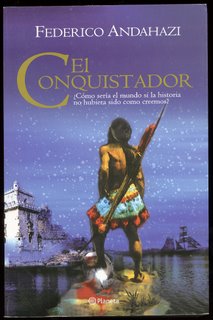 I wrote about "what if" novels here and of a particular one that has some bearing to today's blog here. When Quetza the protagonist of the novel lands in his Mexica made ship near the Spanish town of Huelva (before Columbus was to sail in the opposite direction) relates (my translation of the text) in Federico Andhahazi's El Conquistador : Upon landing Quetza ordered his men to wear their war clothing. They wore breastplates, wide rings around their arms, animal shaped masks and in hand they had their obsidian swords.
Quetza was euphoric to find out that the new lands contained men. He made a sign with his arm to the young man (a shepherd). He wanted to catch up to him to introduce himself. For an instant they stared at each other, transfixed. They were about the same age with the same expression of surprise on their face. Qutza stopped to notice the pale skin and the strange hair with light coloured curls. In spite of the young man's wooden staff he looked harmless. The Mexica captain began in his language, "I am Quetza. I come in my king's name, the emperor of Tenochtitlan. As of now you are his subject..." But before he could finish, the young man ran away as fast as he could until he disappeared at the end of the path. Quetza ordered his men to advance in the same direction to make him understand that he had no reason to fear them. From the above you might suspect that the discovery of the old world by the new was not going to be any different from Columbus's, but you will have to wait for the English translation of this novel as I don't plan to spoil the ending.
The Jeweler, The Soprano, The Baritone & The Jamaican Olympic Bob Sled Team
Sunday, February 03, 2008
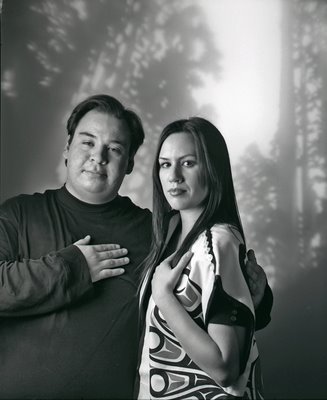 There we were (yesterday afternoon) inside Christ Church Cathedral. Upon entering it Rebecca had said, " While this may be Vancouver's nicest church I think the old churches in Mexico are nicer." We sat down to listen to a performance of Bruce Ruddell's Oratorio, The Spirit of Haida Gwaii with text by Bill Reid. Rebecca understood it had all to do with the story behind Reid's sculpture at Vancouver International Airport and the image on our $20 bills. I was not going to make it more complex to point out that the first Spirit of Haida Gwaii was esconced in Arthur Erickson's Canadian Embassy in Washington, DC. Out of the blue, she asked me, " Who is your favourite bob sled team to win the 2010 Winter Olympic Games in Vancouver? Mine is the Jamaican team." Then she added, " The Swiss team is number 2." At this point the handsome gentleman sitting next to Rebecca interjected, "The Swiss invented the game. I am Swiss." Rebecca looked in his direction and asked him, " Do you speak French? Do you speak German? Do you speak Italian?" The man answered positively to the first two and then said, " I don't speak Italian, I speak Romantsch." 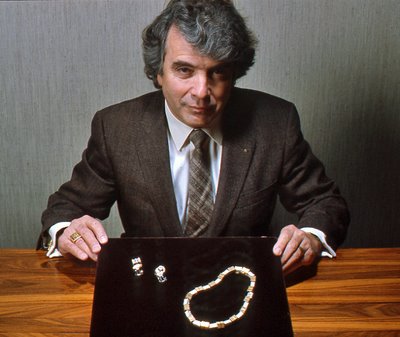 The whole thing had begun when we sat down and I noticed Toni Cavelti and his wife. " I want you to meet "the jeweler," I had told Rebecca." We had a specially nice time as we were sitting behind timpani player Carol Pelkner. Ruddell's Oratorio had many juicy timpani parts and we delighted in Pelkner's performance. The music had some overtones of Benjamin Britten's Young Person's Guide to the Orchestra and Karl Jenkins Palladio. This meant that it was accessible not only to my ears but to Rebecca. She has seen baroque singers before so the excellent performance by baritone Clarence Logan and soprano Melody Mercredi was something she could enjoy while taking in Mercredi's beautiful red silk, bias-cut dress (by Dorothy Grant) with a drop shoulder and a slit to show off Mercredi's legs. When the performance was over we went into the back to talk to Logan and Mercredi. When I asked what was next, Mercredi surprised us by telling us she was going to be performing in the Vancouver Opera's performance of Beethoven's Fidelio starting on March 28. Immediately Rebecca asked, " When was Beethoven born?" As we left we ran into violinist Cam Wilson who told us, " I love playing here. The acoustics are wonderful." What are acoustics," Rebecca asked and we left the church as I explained to her the concept. I called up Bruce Stewart this morning to ask him why Rebecca thinks so much about that Jamaican bob sled team. Rebecca's father told me they have a copy of the 1993 Cool Runnings with John Candy which is about the Jamaican bob sled team's exploits leading to the Calgary Winter Olympics. He further explained the other Jamaican connection of the film's title. It seems singer Bob Marley had that expression in the lyrics to his Blackman Redemption. 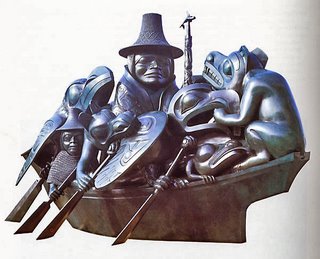 My new Epson scanner, the V700 has a brand new feature I was unaware of. I tried to scan a $20 to show the Bill Reid's image of The Spirit Of Haida Gwaii but a flag went up that steered me to Counterfeit Not!
Alison Denham - Taped Together - Almond Butter Toast
Saturday, February 02, 2008
Rosemary and I watched Alison Denham dance in Taped Together with a clear plastic raincoat last night at Dances for a Small Stage. She was terrific. The very special icing on the cake was that she replaced, at the very last moment, the intended Nureyev for Patrick Pennefather's The Deconstruction of the Dancer. It would seem that Nureyev declined at the last moment. And if that was not all we saw a bit more than twice performances by the exciting duo of Crystal Pite and Cori Caulfield in Farther Out There and Even Further Out There. Dave Brubeck would have been entranced.
The above performances coincided with the publishing of VLM's February issue containing what follows:

AB fab
Last December I watched a performance of Wei Dance's Three Sixty Five at the
East Vancouver Cultural Centre with my 10-year-old granddaughter. It featured six dancers including Wen Wei Wang. But my granddaughter singled out dancer Alison Denham and shouted into my ear, "Look at those abs!"
When I asked Sunshine Coast-born Denham, 29, if her body was due to genes or excercise (I have not seen any other dancer with a similar body), she answered, "Genes mixed perhaps with some excercise."
Denham started dancing recreationally when she was 10. When she was 12 she met retired National Ballet of Canada ballerina Lois Smith, who at the time was living in the Sunshine Coast, and for Denham it all changed. "Through her I saw how serious dance could be and how one could have a life at it. From then on I had classes with Smith every day. By age 14, when Denham finished a Royal Winnipeg Ballet summer program she knew dance was going to be her life. She pursued it at Arts Umbrella and the Ballet BC Mentor Program. She has performances for Judith Marcuse, Paras Terezakis, Judith Garay, Alvin Erasga Tolentino, Serge Bennathan and many others under her belt. She is part of Wen Wei Dance and of Company Erasga.
Suspecting that diet might have something to do with her strong physical condition I asked Denham what she eats on a normal day. "For breakfast I might have a cup of Orange Pekoe tea and toast with almond butter. For lunch it could be sushi, rice with kale, chicken or some meat product. For dinner I would have pesto pasta, avocados and a glass of wine."
After the performance of Three Sixty Five I asked Wen Wei Wang what role Denham played in his company. His answer was short, "She is my mother." Denham explained, "I don't know Wen Wei's mother but I think that he gives me roles that are based on emotion as opposed to physicality. In some way I seem to represent all women for him."
Alison Denham will be performing in May 2008 with the new modern dance company Move: The Company directed by Josh Beamish.
© 2008 VLM/Alex Waterhouse-Hayward
Deborah Does Not Endorse Gleem With GL-70
Friday, February 01, 2008
 It always comes as a shock when I travel to Latin America. In Argentina, four years ago I kept seeing an ad for toothpaste that featured a gorgeous Argentine woman in a bikini. In Mérida last year I was perplexed by huge beer ads similar to the one advertising Howard Hughes's The Outlaw with Jane Russell. The ad read something like, "Two good reasons to drink.....beer." 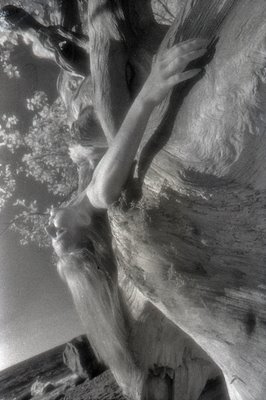 It comes as a shock because we now rarely take advantage of the female form to sell products in Canada. I could not explain our attitude to my Argentine relatives who kept suggesting we Canadians did not have a sense of fun or a passion for life. And when I remember my friend Juan Manuel Sanchez sketching one of our live nude models in my studio I think that the answer must lie somewhere in between. But what is one to do when the phone rings as it did some years ago and the very English Deborah, an acquaintance from my days at Wreck Beach said, "I need you to record my body before nature settles in." What do do? I always comply without feeling too guilty of any kind of exploitation. After all I am not selling the photographs and no product is being advertised. But I have a nagging suspicion that many years from now when some very different imaging technology will be reigning in society these b+w photographs will have their charm, a charm that they presently have for me. 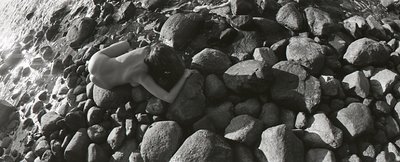
|




